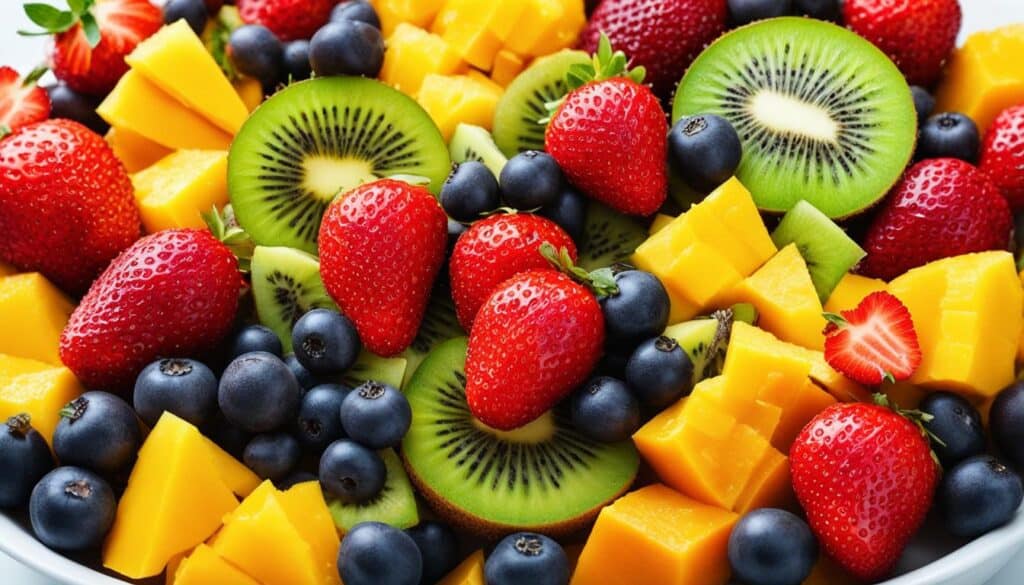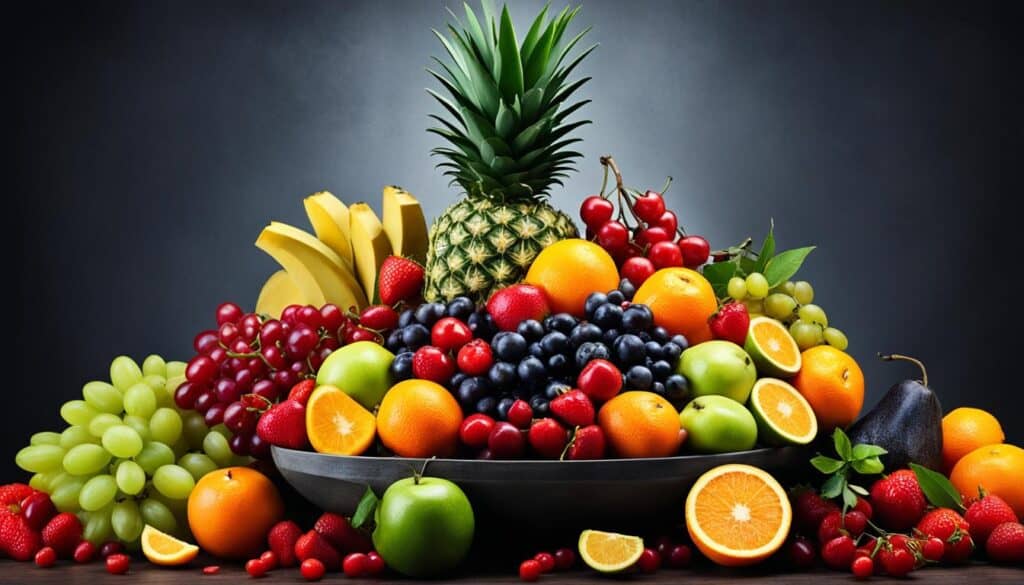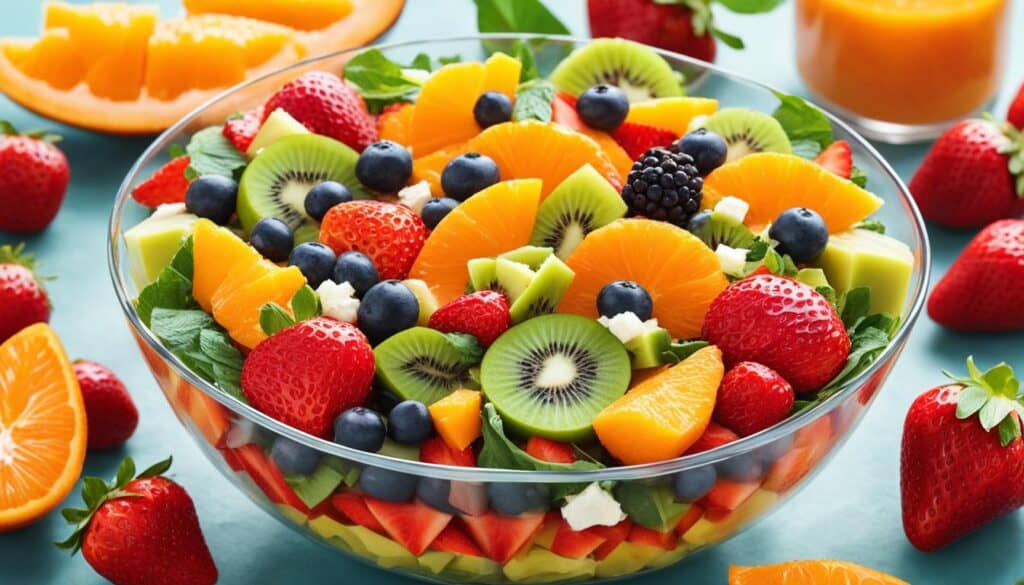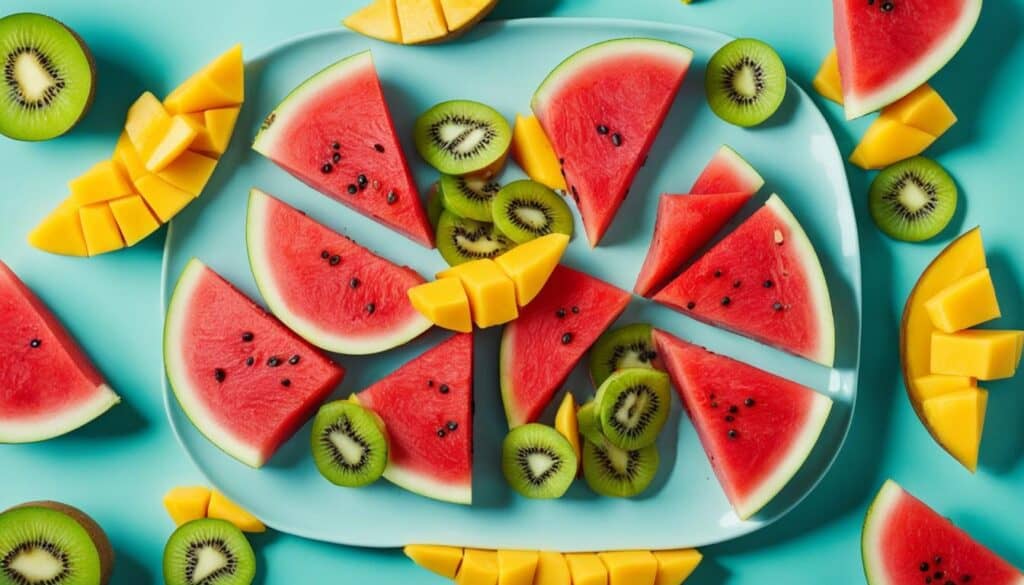Hello, I’m excited to share with you the top fruits that can help boost your hemoglobin levels naturally. Hemoglobin plays a crucial role in carrying oxygen throughout the body, and maintaining optimal levels is essential for overall health and well-being. Low hemoglobin levels can lead to fatigue, weakness, and other symptoms, making it important to incorporate hemoglobin-boosting fruits into your diet.
When it comes to increasing hemoglobin, certain fruits offer a rich source of iron, folic acid, and other essential nutrients. Including these fruits in your daily diet can help elevate your hemoglobin levels and improve your overall health. Let’s explore the best fruits for increasing hemoglobin levels.
Key Takeaways:
- Boosting hemoglobin levels requires consuming foods rich in iron, folic acid, and vitamin B-12.
- Incorporating hemoglobin-boosting fruits like oranges, lemons, pomegranates, and apricots can help increase hemoglobin levels.
- Other fruits such as beetroots, legumes, pumpkin seeds, and raisins also contribute to elevating hemoglobin levels.
- A balanced diet that includes a variety of nutrient-rich foods is essential for maintaining optimal hemoglobin levels.
- Consulting with a healthcare professional or nutritionist can provide personalized guidance for improving hemoglobin levels through diet.
How Does Hemoglobin Work in the Body?
Red blood cells, which contain hemoglobin, play a vital role in the functioning of the human body. Hemoglobin, an iron-rich protein, is responsible for carrying oxygen from the lungs to the body’s cells and tissues, ensuring proper oxygenation and maintaining overall health.
Hemoglobin acts as a carrier for oxygen, binding with oxygen molecules in the lungs and forming a complex called oxyhemoglobin. This complex allows for the efficient transport of oxygen through the bloodstream. Hemoglobin carries about 97% of the total oxygen, while the remaining 3% dissolves in the plasma.
Once in the body’s tissues, hemoglobin releases the oxygen it carries, allowing cells to utilize the oxygen for various metabolic processes. This oxygen exchange occurs through diffusion, where oxygen moves from an area of higher concentration (the blood) to an area of lower concentration (the cells).
The functioning of hemoglobin is intricately connected to the role of red blood cells. These cells are continuously produced in the bone marrow and have a lifespan of about 120 days. The red blood cells are specialized in shape, enabling them to squeeze through narrow blood vessels and deliver oxygen to even the most remote areas of the body.
Proper oxygen transport is essential for the functioning of all body cells and organs. Without sufficient hemoglobin levels, the body may experience oxygen deprivation, leading to fatigue, weakness, and a range of health issues. Therefore, it is crucial to maintain adequate hemoglobin levels for optimal health and well-being.
Now, let’s explore the recommended hemoglobin levels and daily requirements to gain a comprehensive understanding of how to support hemoglobin production and function.
| Hemoglobin Levels | Adult Males (grams per deciliter) | Adult Females (grams per deciliter) |
|---|---|---|
| Ideal Range | 13.5-17.5 | 12.0-15.5 |
Note: These ranges may vary based on factors such as age, sex, and individual health conditions.
Recommended Hemoglobin Levels and Daily Requirements
In order to maintain optimal health, it is important to understand the ideal hemoglobin levels and the recommended daily intake of hemoglobin. Hemoglobin levels can vary based on factors such as age, sex, and specific dietary needs. For adults, the ideal hemoglobin levels are between 13.5-17.5 grams per deciliter for males and 12.0-15.5 grams per deciliter for females.
However, it’s important to note that these values can vary slightly depending on the reference range used by different laboratories and medical professionals. If you have concerns about your hemoglobin levels, it is best to consult with a healthcare provider for a personalized assessment.
The recommended daily intake of hemoglobin also varies based on individual needs. Generally, a balanced diet that includes iron-rich foods, vitamin B-12, and folic acid is essential for maintaining healthy hemoglobin levels. Iron is crucial for the production of hemoglobin, while vitamin B-12 and folic acid play a role in the formation of red blood cells.
To meet the recommended daily intake of hemoglobin, it is advisable to include a variety of nutrient-dense foods in your diet. This can include:
- Lean meats, poultry, and fish
- Legumes, such as beans, lentils, and chickpeas
- Dark green leafy vegetables, like spinach and kale
- Fruits rich in vitamin C, such as oranges and strawberries
- Foods fortified with vitamin B-12 and folic acid, like breakfast cereals and nutritional yeast
By following a balanced diet and consuming foods that support healthy hemoglobin levels, you can ensure your body has the necessary nutrients to function optimally.
| Demographic | Ideal Hemoglobin Levels (g/dL) |
|---|---|
| Adult Males | 13.5-17.5 |
| Adult Females | 12.0-15.5 |
Why are Ideal Hemoglobin Levels Important?
Maintaining optimal hemoglobin levels is crucial for overall health and well-being. Hemoglobin is responsible for carrying oxygen from the lungs to the body’s tissues and organs. Insufficient hemoglobin levels can lead to anemia, which can cause symptoms such as fatigue, weakness, and shortness of breath.
Having the right hemoglobin levels ensures that your body’s cells receive an adequate supply of oxygen, enabling them to function properly. It is important to monitor your hemoglobin levels and make necessary dietary adjustments to maintain optimal health.
Vitamin C-Rich Fruits for Hemoglobin Increase
Vitamin C plays a crucial role in maintaining hemoglobin levels by aiding in iron absorption in the body. Including fruits high in vitamin C in your diet can be an effective way to support healthy hemoglobin production. Let’s take a look at some of the top vitamin C-rich fruits:
1. Oranges
Oranges are not only delicious but also packed with vitamin C. Just one medium-sized orange can provide up to 70% of your daily vitamin C requirement[1]. Enjoying an orange as a snack or adding its juice to your smoothies can help increase your vitamin C intake and support hemoglobin production.
2. Lemons
Lemons are known for their tangy taste, but they are also an excellent source of vitamin C. Squeeze some lemon juice into your water or use it as a dressing for salads to incorporate this vitamin C-rich fruit into your daily routine.
3. Bell Peppers
Bell peppers come in a variety of colors and are a versatile ingredient in many dishes. They are not only crunchy and flavorful but also packed with vitamin C. Whether you prefer red, yellow, or green bell peppers, adding them to your meals can help increase your vitamin C intake and support hemoglobin levels.
4. Strawberries
Indulge in the sweetness of strawberries while boosting your vitamin C levels. These juicy berries are a fantastic source of vitamin C and can be enjoyed on their own, in smoothies, or as a topping for yogurt or cereal.
5. Grapefruits
Grapefruits are a refreshing citrus fruit that provides an abundance of vitamin C. Enjoy them for breakfast or as a healthy snack to boost your vitamin C intake and support your hemoglobin levels.
By incorporating these vitamin C-rich fruits into your diet, you can enhance your body’s ability to absorb iron and maintain optimal hemoglobin levels.

[1]Source: National Institutes of Health. Vitamin C – Health Professional Fact Sheet
Iron-Rich Fruits for Hemoglobin Increase
Iron deficiency is one of the common causes of low hemoglobin levels. Including iron-rich fruits in your diet can help increase hemoglobin levels and prevent anemia. Here are some fruits that are high in iron:
| Fruit | Iron Content (per 100g) |
|---|---|
| Pomegranate | 0.35mg |
| Dates | 0.90mg |
| Watermelon | 0.24mg |
These iron-rich fruits not only help increase hemoglobin levels but also provide other essential nutrients. Pomegranate is packed with antioxidants and has been shown to improve blood flow. Dates are a great source of fiber and natural sugars, but individuals with diabetes should monitor their intake due to the high sugar content. Watermelon is not only hydrating but also rich in lycopene, a powerful antioxidant.
By incorporating these iron-rich fruits into your diet, you can boost your hemoglobin levels naturally and support overall health and well-being.

The Importance of Iron in Hemoglobin Production
Iron plays a vital role in the production of hemoglobin, the protein responsible for carrying oxygen in the blood. Without sufficient iron, your body may not be able to produce enough hemoglobin, leading to low hemoglobin levels and potential health issues.
Folic Acid-Rich Fruits for Hemoglobin Increase
Folic acid plays a crucial role in the production of red blood cells, making it essential for maintaining healthy hemoglobin levels. Including fruits rich in folic acid in your diet can have significant benefits in supporting hemoglobin increase. Apricots, bananas, and oranges are excellent sources of folic acid and can contribute to maintaining sufficient hemoglobin levels. Incorporating these fruits into your daily meals or snacks is a simple and delicious way to boost your folic acid intake and support your overall health.

The Role of Folic Acid in Hemoglobin Production
Folic acid, also known as vitamin B9, is a water-soluble vitamin that plays a crucial role in the synthesis of DNA and RNA, the genetic materials in our cells. It is particularly important for the formation of red blood cells, which contain hemoglobin. Hemoglobin carries oxygen from the lungs to the body’s tissues and organs, ensuring their proper functioning.
When our body lacks folic acid, the production of red blood cells is compromised. This can lead to a decrease in hemoglobin levels, resulting in anemia, fatigue, and other health issues. By including folic acid-rich fruits in your diet, you can provide your body with the necessary nutrients to support the production of healthy red blood cells and maintain optimal hemoglobin levels.
A Selection of Folic Acid-Rich Fruits
Here are some fruits that are known for their high folic acid content:
- Apricots
- Bananas
- Oranges
These fruits not only provide a good amount of folic acid but also offer various other essential nutrients, such as vitamins, minerals, and antioxidants, which contribute to overall health and well-being. Including a variety of folic acid-rich fruits in your daily diet can be a tasty and convenient way to support your hemoglobin increase efforts.
| Fruit | Folic Acid Content (per 100g) |
|---|---|
| Apricots | 13 mcg |
| Bananas | 20 mcg |
| Oranges | 30 mcg |
Table: Folic Acid Content in Selected Fruits (per 100g)
While the folic acid content in fruits may vary, incorporating them into your diet can contribute to meeting your daily folic acid requirements and supporting hemoglobin increase. Remember to enjoy these fruits as part of a balanced diet that includes other essential nutrients for overall health.
Other Fruits for Hemoglobin Increase
In addition to the previously mentioned fruits, there are various other options that can help increase hemoglobin levels. Including a variety of these fruits in your diet can provide a range of nutrients necessary for maintaining hemoglobin levels.
- Beetroots: Beetroots are especially beneficial as they are high in iron, folic acid, and fiber. They can help boost hemoglobin levels effectively.
- Legumes: Legumes such as lentils, chickpeas, and kidney beans are rich in iron, protein, and other essential nutrients that support hemoglobin production.
- Pumpkin Seeds: Pumpkin seeds are a good source of iron, magnesium, and zinc, which play a vital role in hemoglobin synthesis.
- Raisins: Raisins are not only a delicious snack but also rich in iron and other essential minerals that contribute to healthy hemoglobin levels.
Incorporating these additional fruits into your diet can help ensure a well-rounded intake of nutrients that support hemoglobin increase.

| Fruit | Nutrients | Role in Hemoglobin Increase |
|---|---|---|
| Beetroots | Iron, Folic Acid, Fiber | High iron content aids in hemoglobin production |
| Legumes | Iron, Protein, Essential Nutrients | Nutrient-rich composition supports hemoglobin synthesis |
| Pumpkin Seeds | Iron, Magnesium, Zinc | Essential minerals contribute to hemoglobin production |
| Raisins | Iron, Essential Minerals | Rich iron content helps boost hemoglobin levels |
By incorporating a diverse range of fruits into your diet, you can provide your body with the necessary nutrients to maintain healthy hemoglobin levels.
Dietary Tips for Hemoglobin Increase
In addition to incorporating hemoglobin-boosting fruits into your diet, it is important to consume a balanced diet that includes other sources of iron, folic acid, and vitamin B-12. These nutrients play a crucial role in maintaining healthy hemoglobin levels.
Include Green Leafy Vegetables
Green leafy vegetables such as spinach, kale, and broccoli are excellent sources of iron and folic acid. They also provide essential vitamins and minerals that support red blood cell production and hemoglobin synthesis.
Include Sesame Seeds
Sesame seeds are rich in iron, making them an ideal addition to your diet for boosting hemoglobin levels. Consider sprinkling them on salads, cereal, or incorporating them in your cooking to increase your iron intake.
Consider Moringa Leaves
Moringa leaves are packed with essential nutrients, including iron, vitamin C, and vitamin B-12. Adding moringa leaves to your diet can be beneficial in increasing hemoglobin levels naturally.
Avoid Foods that Hinder Iron Absorption
Sometimes, certain foods can hinder iron absorption in the body. It is advisable to limit the consumption of tea, coffee, and cocoa, as they contain compounds that inhibit iron absorption. Instead, opt for herbal teas or consume these beverages separately from iron-rich meals to maximize absorption.
Tip: Try drinking a glass of vitamin C-rich fruit juice with your iron-rich meals to enhance iron absorption.
Dietary Recommendations for Hemoglobin Increase
| Nutrient | Food Sources |
|---|---|
| Iron | Green leafy vegetables, sesame seeds, lentils, fortified cereals |
| Folic Acid | Green leafy vegetables, citrus fruits, beans, lentils, fortified grains |
| Vitamin B-12 | Eggs, dairy products, poultry, seafood, fortified cereals |
By incorporating these dietary tips into your everyday routine, you can support your body’s ability to produce and maintain healthy levels of hemoglobin. Remember to consult with a healthcare professional or a registered dietitian for personalized dietary guidance.

Conclusion
Maintaining adequate hemoglobin levels is vital for overall health and well-being. By including a variety of hemoglobin-boosting fruits and nutrient-rich foods in your daily diet, you can naturally elevate your hemoglobin levels. Fruits rich in vitamin C, such as oranges and strawberries, can enhance iron absorption, while iron-rich options like pomegranates and watermelons provide essential nutrients for hemoglobin production. Folic acid-rich fruits like bananas and apricots support red blood cell production, further contributing to hemoglobin increase.
However, it’s important to remember that a balanced diet is crucial for hemoglobin improvement. Alongside these hemoglobin-boosting fruits, incorporating other sources of iron, folic acid, and vitamin B-12 into your meals is recommended. Green leafy vegetables, sesame seeds, and moringa leaves are excellent additions to your diet to maintain healthy hemoglobin levels. Additionally, it is advised to avoid foods such as tea, coffee, and cocoa, as they can hinder iron absorption.
For personalized dietary guidance tailored to your specific needs, it’s always best to consult with a healthcare professional or nutritionist. They can provide you with expert advice on creating a well-rounded diet plan that supports your body’s natural ability to produce and maintain healthy levels of hemoglobin. Making informed dietary choices is an important step towards optimizing your hemoglobin levels and promoting overall health and vitality.
FAQ
What is hemoglobin?
Hemoglobin is an iron-rich protein present in red blood cells that carries oxygen throughout the body.
How does hemoglobin work in the body?
Hemoglobin is responsible for transporting oxygen from the lungs to the body’s cells, ensuring their proper functioning.
What are the recommended hemoglobin levels?
The ideal hemoglobin levels for males are 13.5-17.5 grams per deciliter, and for females, they are 12.0-15.5 grams per deciliter.
What are the daily requirements for hemoglobin?
The recommended daily intake of hemoglobin may vary based on age, sex, and specific dietary needs.
Which fruits are high in vitamin C and can help increase hemoglobin levels?
Fruits such as oranges, lemons, bell peppers, strawberries, and grapefruits are rich sources of vitamin C.
Which fruits are high in iron and can help increase hemoglobin levels?
Pomegranates, dates, and watermelon are iron-rich fruits that can help increase hemoglobin levels.
What fruits are rich in folic acid and can help increase hemoglobin levels?
Apricots, bananas, and oranges are fruits that are rich in folic acid and can help increase hemoglobin levels.
Are there any other fruits that can help increase hemoglobin levels?
Yes, beetroots, legumes, pumpkin seeds, and raisins are some other fruits that can help increase hemoglobin levels.
What are some dietary tips for increasing hemoglobin levels?
In addition to consuming hemoglobin-boosting fruits, it is recommended to include green leafy vegetables, sesame seeds, and moringa leaves in your diet. Avoiding foods that hinder iron absorption, such as tea, coffee, and cocoa, is also advised.
How can a balanced diet support hemoglobin increase?
Consuming a balanced diet that includes a variety of hemoglobin-boosting fruits and other nutrient-rich foods provides the necessary nutrients for maintaining adequate hemoglobin levels.
Source Links
- https://www.ndtv.com/health/9-foods-that-can-help-increase-haemoglobin-1828770
- https://redcliffelabs.com/myhealth/food-and-nutrition/food-for-blood/top-haemoglobin-foods-that-can-increase-your-haemoglobin-naturally/
- https://www.metropolisindia.com/blog/lifestyle/top-foods-that-can-boost-your-hemoglobin-naturally





Leave a Reply